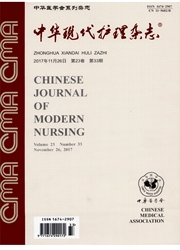

 中文摘要:
中文摘要:
目的:探讨桡动脉路径行冠状动脉介入( TRI)术后使用纱布绷带加压止血患者腕部首次减压的最佳时间。方法选择TRI术后患者165例,随机分为观察组(n=85)和对照组(n=80),观察组术后60 min首次松解绷带,对照组术后90 min 首次松解绷带,观察两组患者术后15,30,45,60,90,120 min术侧及健侧指端血氧饱和度( SpO2),比较两组患者血管并发症和舒适度。结果观察组患者术后15min术侧SpO2(94.48±2.585)%,健侧(95.06±2.014)%,差异有统计学意义(t=-0.118,P〈0.05);对照组首次松解绷带后30 min 即术后120 min 术侧 SpO2(94.41±1.992)%,健侧(95.25±2.149)%,差异有统计学意义(t=-3.617,P〈0.01);两组患者术后6个时间点术侧SpO2比较差异无统计学意义(t值分别为-0.233,0.269,0.992,-0.203,0.297,0.670;P〉0.05)。两组患者均未出现切口渗血和桡动脉闭塞,观察组发生前臂肿胀1例,皮下血肿1例,两组患者术后手部舒适感和血管并发症比较差异无统计学意义(χ^2值分别为4.023,1.418;P〉0.05)。结论 TRI术后60 min首次松解绷带减压,可以降低血管并发症发生的风险,增加患者舒适度。
 英文摘要:
英文摘要:
Objective To explore the best time for the first wrist bandage decompression in patients with coronary artery intervention after radial artery puncture operation. Methods A total of 165 patients were randomly divided into observation group ( n=85 ) and control group ( n=80 ) . Wrist bandage decompression time was 60 min and 90 min after operation in the observation group and in the control group. We recorded blood oxygen saturation (SpO2) of operated hand and unaffected hand at 15, 30, 45, 60, 90 and 120 min of post-operation. Then, we compared the differences of vascular complication and degrees of comfort. Results The SpO2 was (94. 48 ± 2. 585)% and (95. 06 ± 2. 014)% in operated hand and unaffected hand at 15 min after operation in the observation group (t= -0. 118, P〈0. 05). The SpO2 was (94. 41 ± 1. 992)% and (95. 25 ± 2. 149)% in operated hand and unaffected hand at 120 min in the control group (t= -3. 617, P〈0. 01). The SpO2 was no significant difference between these six time points in operated hand (t= -0. 233, 0. 269, 0. 992,-0. 203, 0. 297, 0. 670; P〉0. 05). There was no incision bleeding and radial artery occlusion in both two groups. There was 1 case upper arm swelling and 1 case ecchymoma in the observation group. There was no statistically difference between vascular complication and degree of comfort (χ^2 =4. 023, 1. 418, P〉0. 05). Conclusions Best time for the first wrist bandage decompression was 60 min after coronary artery intervention, which can decrease the risks of vascular complication and increase degree of comfort.
 同期刊论文项目
同期刊论文项目
 同项目期刊论文
同项目期刊论文
 期刊信息
期刊信息
